Notes
How Many W's Would You Give Me For An FDR?
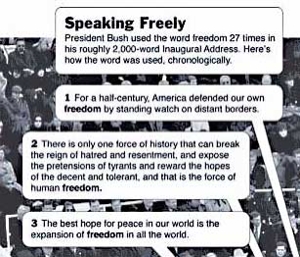
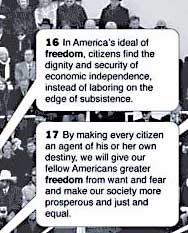
Whoa. I got so distracted by the Iraqi elections, I almost completely forgot about Bush’s coronation. (I mean, inauguration.) (…Or maybe I was right the first time.)
One of the reasons I think its important to track-back is because the Republican linguistic experts used the event to begin mainstreaming a new set of catch words. Of course, you’ve probably noticed that, in a little over a week and a half, the Administration has practically drained the relevance out of the terms “freedom” and “democracy.”
If the highjacking of these terms is already clear, the extent of their deployment (or diminishment?) is still unfolding. Studying the coronation, however, one use of these swooping terms was to assist in the not so subtle marketing effort to secure Bush a respectable place in history. (You do remember that early shot of Bush in front of Mt. Rushmore, don’t you?)
To track the genesis of any Bush campaign, you have to go to the source. Speaking to the AP on January 19th, Karl Rove telegraphed the legacy campaign by denying the administration’s preoccupation with history. Said Karl:
The President is “focused, upbeat, optimistic” about his new term. “Anybody who’s concerned about creating a legacy will fall short if he’s not focused … on the right policy and service to the country. And let history take care of itself.”
Interesting comment, especially the emphasis on creating legacy, as opposed to simply leaving it to the ages.
The day before, Bush opened the coronation’s three day $40 million orgy of self-congratulation with a lavish two-hour tribute to the United States military. Video histories were shown of four armed services, being sure to connect historic footage (from Iwo Jima and Vietnam) with scenes from the two wars Bush started. For good measure, a further historical link was made by having Bush 41 read a letter he wrote home after getting shot down during WWII. In his remarks, the President kept the h-word going, recounting America’s role in Afghanistan’s “first free elections of that nation’s 5,000-year history.”
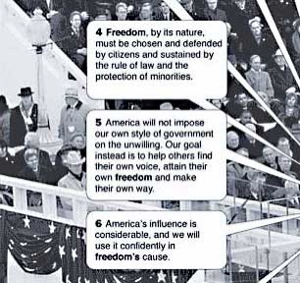
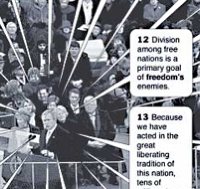
The President finished his remarks with a double play, tying in the history theme with the freedom meme. “The inauguration of a president is a great moment in the life of our country,” he said. “With an election behind us, the American people come together in unity to celebrate our freedom.” Then program organizers hammered the theme still further, stressing that the two wars fought in Mr. Bush’s first term were part of “America’s history of helping nations.”
The next day, Bush attended a private event at the Andrew W. Mellon Auditorium for his largest financial backers. The donors in attendance were people who had contributed at least $250,000 each to help pay for the coronation. Bush’s comments were not released publicly, but Scott McClellan, the White House spokesman said that Mr. Bush spoke about “the significance of this moment in our history.”
The following morning, Bush prepared for his coronation speech by visiting the National Archives to view George Washington’s handwritten 1789 inaugural address, and original versions of the Declaration of Independence, the Constitution and the Bill of Rights. Bush told reporters he was “absolutely” feeling the history of the moment. According to the Washington Post, Bush also talked privately to inauguration organizers about the “significance of this moment in our history.”
Reinforcing the story line, there was also a continuous drumbeat of references to more well-regarded past Presidents. For example, Ken Mehlman, who was sworn in as chairman of the Republican National Committee the morning of the coronation, would refer to the Republicans as “the party of Lincoln and Reagan and Bush.”
We know that the coronation speech was lampooned for it’s who-knows-how-many drafts, and its mention of freedom in almost every other breath. (The images I’ve interspersed are from a special NYTimes graphic illustrating all 27 references to “freedom” in the Bush speech.)
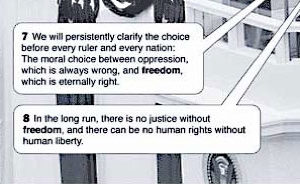
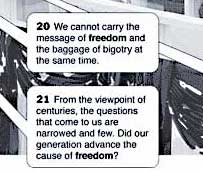
For Rove and Co, however, the coronation speech was considered the masterstroke. Even though some conservatives (like Peggy Noonan and William Buckley ) couldn’t make any sense of it, the Bush image factory, in collusion with the neocon crowd, trumpeted it as, what else? A historic new doctrine. And who better to glorify the “legacy” agenda through his own historical overkill than William Kristol, who wrote (and, you’ve just got to love this for packing the references):
INFORMED BY STRAUSS and inspired by Paine, appealing to Lincoln and alluding to Truman, beginning with the Constitution and ending with the Declaration, with Biblical phrases echoing throughout–George W. Bush’s Second Inaugural was a powerful and subtle speech.
If you read Kristol’s article, you’ll see that he also threw in Reagan and Kennedy, to boot.
The real question, though, is not whether the new language, and the emphasis on legacy, and the historical references were heavy-handed, or stilted, or off-putting, but whether (according to the genius of Karl Rove) they sank in.
Well, not three days later, the NYTimes dedicated its feature piece in the “Week in Review” section to Bush’s Social Security scheme. In doing so, The Times created a visual juxtaposition between FDR and Bush that was so similar one couldn’t help but draw some equivalence between the two.
It was not just the visuals that sets Bush on par with Roosevelt, however, By juxtaposing the titles “New Deal” and “New New Deal,” it also set up a equivalency between Bush’s strategy and one of America’s most important and enduring social programs. In fact, it went farther than that. Basically, it took Bush’s plan (which is currently no more substantial than something scribbled on the back of a napkin) and designated it as the New Deal’s successor.
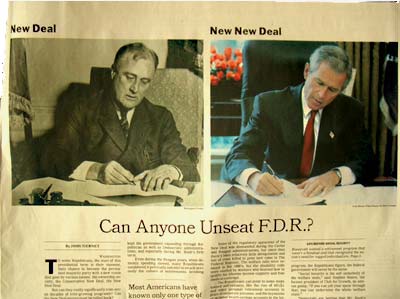
(Speaking Freely” graphic — NYTimes Week In Review 1/23/05; images: Bettmann/Corbis and Paul Morse/White House via Getty Images)

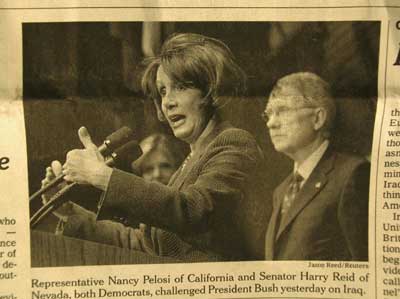
Reactions
Comments Powered by Disqus